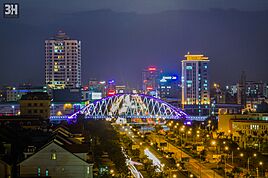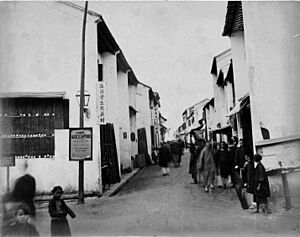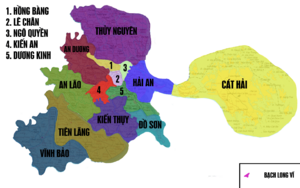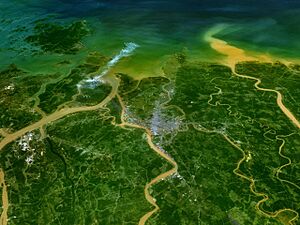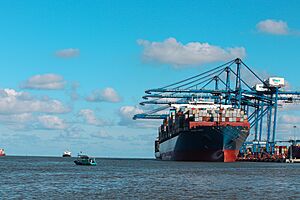Haiphong facts for kids
Quick facts for kids
Haiphong
Hải Phòng
|
|
|---|---|
|
Municipality (Class-1)
|
|
| City of Haiphong Thành phố Hải Phòng |
|
|
From top, left to right: Downtown Haiphong, Haiphong seen from Haiphong Opera House, Lê Chân statue, Nguyen Binh Khiem overpass, Hai Phong Port, Đồ Sơn.
|
|
| Nickname(s):
Flamboyant City (Thành phố hoa phượng đỏ)
|
|
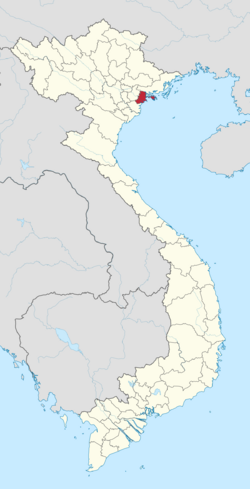
Provincial location in Vietnam
|
|
| Country | |
| Region | Red River Delta |
| Seat | Hồng Bàng |
| Subdivision | 7 urban districts, 8 rural districts |
| Government | |
| • Type | Municipality |
| • Body | Haiphong People's Council |
| Area | |
| • Municipality (Class-1) | 1,526.52 km2 (589.39 sq mi) |
| Population
(2022)
|
|
| • Municipality (Class-1) | 2,088,000 |
| • Density | 1,367.8/km2 (3,542.6/sq mi) |
| • Urban | 951,723 |
| Ethnic groups | |
| • Vietnamese | 99.6% |
| • Others | 0.4% |
| Time zone | UTC+07:00 (ICT) |
| Postal code |
04xxx–05xxx
|
| Area codes | 225 |
| License plate | 15, 16 |
| GRP (Nominal) | 2020 |
| - Total | US$12 billion |
| - Per capita | US$5.863 |
| HDI (2020) | 0.782 (4th) |
| Climate | Cwa |
| International airport | Cat Bi International Airport |
Haiphong (Vietnamese: Hải Phòng) is a large city in Vietnam. It is the third-largest city and a very important port city in the Red River Delta region. The city covers about 1,526 square kilometers (589 square miles). It includes 8 city districts and 7 rural districts. Two of these rural districts are islands in the South China Sea. In 2021, Haiphong had a population of 2,359,000 people. The city is known for its strong manufacturing industry, with many factories and traditional craft villages. Haiphong was also the first place in Vietnam to have electricity.
Historically, the Bạch Đằng River in Haiphong was the site of famous victories. Vietnamese heroes like Ngô Quyền and Trần Hưng Đạo led battles there. In the 16th century, the Mạc dynasty made Haiphong a key port. Later, in 1888, the French made it one of the main cities of French Indochina. From 1954 to 1975, Haiphong was the most important port for North Vietnam. Today, it is one of Vietnam's major cities, like Hanoi and Ho Chi Minh City. Haiphong is also a popular place for beach vacations. It has special nature reserves on Cát Bà Island. The city is also home to the main base of the Vietnam People's Navy. The beautiful Royal poinciana flower is a symbol of Haiphong in Vietnamese culture.
Contents
- Haiphong's Rich History
- Exploring Haiphong's Geography
- Haiphong's Administrative Divisions
- Haiphong's Economy and Industries
- Haiphong's Population
- Education in Haiphong
- Getting Around Haiphong: Transport
- Delicious Haiphong Cuisine
- Famous People from Haiphong
- Haiphong's Sister Cities
- Images for kids
- See also
Haiphong's Rich History
Early Beginnings and Dynasties
Modern Haiphong was once the home of Lê Chân. She was a brave female general who fought alongside the Trưng Sisters. They led a rebellion against Chinese rule around 40 AD. Lê Chân helped set up the "Defenced Sea-coast" during these wars.
Centuries later, during the Nguyễn dynasty, the area was called "The trading defensive area of Hải Dương Province". By the 19th century, the Hang Kenh Communal House became an important administrative center. The area had already grown into a busy trading port.
In 1881, a big typhoon hit Haiphong. It caused a lot of damage and killed about 3,000 people. Despite this, the French later developed Haiphong into a major naval base for French Indochina.
Haiphong During the Vietnam War
After World War II, Vietnam wanted to be independent from France. French forces landed in Haiphong, and fighting broke out. French ships then shelled the city, causing a fire. This event helped start the First Indochina War.
Later, during the Vietnam War, Haiphong was heavily bombed by the US Navy and US Air Force. This was because it was North Vietnam's only major port. In 1972, the U.S. military placed mines in Haiphong harbor. This stopped ships from entering or leaving. Even with the bombings, most of the city's buildings were not destroyed. This was because the U.S. had rules about not hitting certain areas. After the war, Haiphong quickly became an important industrial city again.
Exploring Haiphong's Geography
Haiphong is a coastal city. It is located where the Cấm River meets the sea. The city is about 120 kilometers (75 miles) east of Hanoi. The Bính Bridge crosses the Cấm River, connecting the city to Thủy Nguyên District. Haiphong borders Quảng Ninh Province to the north and Hải Dương Province to the west. To the south is Thái Bình Province, and to the east is the Gulf of Tonkin. Islands like Bach Long Vi, Cat Ba Island, and Long Châu are also part of Haiphong.
Haiphong's Climate
Haiphong has a humid subtropical climate. This means it has hot, humid summers and warm, dry winters. Most of the rain falls between April and October. About 1,700 millimeters (67 inches) of rain falls each year.
There is a clear difference in temperatures between winter and summer. The coolest months are January and February. During these months, the average high temperature is about 20°C (68°F). The average low is around 14°C (57°F). The warmest months are June and July. High temperatures average around 33°C (91°F), and lows are about 26°C (79°F). The sea temperature is coolest in February at 21°C (70°F). It gets warmest in July and August at 30°C (86°F).
| Climate data for Haiphong (Phù Liễn, Kiến An district) | |||||||||||||
|---|---|---|---|---|---|---|---|---|---|---|---|---|---|
| Month | Jan | Feb | Mar | Apr | May | Jun | Jul | Aug | Sep | Oct | Nov | Dec | Year |
| Record high °C (°F) | 31.0 (87.8) |
34.1 (93.4) |
35.4 (95.7) |
37.4 (99.3) |
41.5 (106.7) |
39.5 (103.1) |
38.5 (101.3) |
39.4 (102.9) |
37.4 (99.3) |
36.6 (97.9) |
33.1 (91.6) |
30.0 (86.0) |
41.5 (106.7) |
| Mean daily maximum °C (°F) | 19.8 (67.6) |
20.1 (68.2) |
22.2 (72.0) |
26.4 (79.5) |
30.6 (87.1) |
32.0 (89.6) |
32.1 (89.8) |
31.5 (88.7) |
30.8 (87.4) |
29.0 (84.2) |
25.8 (78.4) |
22.1 (71.8) |
26.9 (80.4) |
| Daily mean °C (°F) | 16.3 (61.3) |
17.0 (62.6) |
19.4 (66.9) |
23.1 (73.6) |
26.6 (79.9) |
28.2 (82.8) |
28.4 (83.1) |
27.8 (82.0) |
26.9 (80.4) |
24.7 (76.5) |
21.5 (70.7) |
18.1 (64.6) |
23.2 (73.8) |
| Mean daily minimum °C (°F) | 14.2 (57.6) |
15.2 (59.4) |
17.7 (63.9) |
21.1 (70.0) |
24.1 (75.4) |
25.6 (78.1) |
25.9 (78.6) |
25.3 (77.5) |
24.3 (75.7) |
22.0 (71.6) |
18.8 (65.8) |
15.5 (59.9) |
20.8 (69.4) |
| Record low °C (°F) | 4.5 (40.1) |
4.5 (40.1) |
6.1 (43.0) |
10.4 (50.7) |
15.5 (59.9) |
18.4 (65.1) |
20.3 (68.5) |
20.4 (68.7) |
15.6 (60.1) |
12.7 (54.9) |
9.0 (48.2) |
4.9 (40.8) |
4.5 (40.1) |
| Average rainfall mm (inches) | 28.0 (1.10) |
27.4 (1.08) |
48.5 (1.91) |
85.3 (3.36) |
201.6 (7.94) |
238.1 (9.37) |
238.1 (9.37) |
353.0 (13.90) |
257.1 (10.12) |
136.3 (5.37) |
43.0 (1.69) |
22.8 (0.90) |
1,679.3 (66.11) |
| Average rainy days | 8.4 | 12.8 | 17.1 | 12.9 | 12.6 | 14.1 | 14.2 | 17.5 | 13.8 | 9.7 | 6.4 | 5.5 | 145.2 |
| Average relative humidity (%) | 84.4 | 88.5 | 90.9 | 90.7 | 87.5 | 86.8 | 86.6 | 88.4 | 86.3 | 82.3 | 79.8 | 79.5 | 86.0 |
| Mean monthly sunshine hours | 82.0 | 46.6 | 41.3 | 85.0 | 183.7 | 181.3 | 199.1 | 169.5 | 179.1 | 179.8 | 148.5 | 126.8 | 1,624.8 |
| Source 1: Vietnam Institute for Building Science and Technology | |||||||||||||
| Source 2: The Yearbook of Indochina (1930-1931) | |||||||||||||
| Month | Jan | Feb | Mar | Apr | May | Jun | Jul | Aug | Sep | Oct | Nov | Dec | Year |
|---|---|---|---|---|---|---|---|---|---|---|---|---|---|
| Average temperature °C (°F) | 22 °C (72 °F) | 21 °C (70 °F) | 22 °C (72 °F) | 24 °C (75 °F) | 27 °C (81 °F) | 29 °C (84 °F) | 30 °C (86 °F) | 30 °C (86 °F) | 29 °C (84 °F) | 28 °C (82 °F) | 26 °C (79 °F) | 23 °C (73 °F) | 26 °C (79 °F) |
Haiphong's Administrative Divisions
Haiphong is divided into 15 main areas called districts.
- 8 rural districts (countryside areas):
- An Dương
- An Lão
- Bạch Long Vĩ
- Cát Hải
- Kiến Thụy
- Tiên Lãng
- Vĩnh Bảo
- Thủy Nguyên
- 7 urban districts (city areas):
- Dương Kinh
- Đồ Sơn
- Hải An
- Kiến An
- Hồng Bàng
- Ngô Quyền
- Lê Chân
These districts are further divided into smaller towns, communes (like villages), and wards (parts of a city).
Haiphong's Economy and Industries
Haiphong is a very important economic hub in northern Vietnam. In the past, during French rule, Haiphong was considered a top city, just like Saigon and Hanoi. The French even thought about making it the economic capital of Indochina.
Today, Haiphong continues to be one of Vietnam's most important economic centers. The city's income has grown a lot over the years. In 2015, its total income was 56,288 billion Vietnamese Dong. The government plans for this to grow even more by 2020. Haiphong trades goods with over 40 countries around the world. The city is working hard to become one of the country's biggest trading centers.
In 2023, Haiphong scored well on Vietnam's Provincial Competitiveness Index. This index checks how good a place is for businesses. Haiphong got high scores for its labor policies and how quickly things get done.
What Haiphong Makes: Industry and Products
Industry is a key part of Haiphong's economy. This includes making food, light goods, and heavy industrial products. Some major products are fish sauce, beer, cigarettes, and textiles (like cloth). They also make paper, plastic pipes, cement, iron, and medicines. Other products include electric fans, motorbikes, steel pipes, and ships. The city also does work in software development.
Many of these industries have grown a lot between 2000 and 2007. Shipbuilding, steel pipes, plastic pipes, and textiles are some of the fastest-growing areas. New industries are also starting up to supply products needed by existing factories. For example, a new factory was built to make polyester fiber. This helps Vietnam rely less on imported materials. In Haiphong, 270,600 people work in various industries.
Farming, Fishing, and Forests
Even though Haiphong is a big city, about one-third of its land is used for farming. Rice is the most important crop. It covers about 80% of the farmland. Other farm products include corn, sugar, and peanuts.
Haiphong also has a large fishing industry. The amount of fish caught and raised has almost doubled between 2000 and 2007. Most of this growth comes from aquaculture, which is farming fish and seafood in water. Even though Haiphong is on the coast, sea fish make up only a small part of its fishing industry.
In 2007, about 315,500 people worked in farming and fishing. This number was lower than in 2000. However, these jobs still make up a big part of Haiphong's total employment.
Haiphong's Population
Haiphong is the third most populated city in Vietnam. In 2015, the greater city area had about 2,103,500 people. About 46% of these people live in the city's urban districts. The population is almost evenly split between males and females.
How Haiphong's Population is Growing
In 2009, Haiphong's population grew by about 4% each year. For every 1,000 people, there were 18.1 births and 7.6 deaths. People in Haiphong live a long time. Women live to about 77.1 years, and men live to about 72.0 years. On average, people live to 74.5 years. The number of babies who did not survive was 11.8 for every 1,000 live births. This was a bit higher than the average for urban areas in Vietnam. More people moved into Haiphong than moved out.
Education in Haiphong
Haiphong has several important schools and universities:
- Hai Phong Medical University
- Hai Phong University
- Tran Phu High School for the gifted
- Vietnam Maritime University
Getting Around Haiphong: Transport
Roads for Travel
Haiphong is connected by two main national highways. Route 5 goes west to Hanoi. Route 10 goes south to Nam Định and connects to National Route 1 at Ninh Bình. Highway 356 goes through the city center to the coast. A new highway connecting Haiphong and Hanoi was finished in 2015. It is Vietnam's most modern highway and makes the trip much faster.
Within the city, there are several bus stations for long-distance travel. These include Niem Nghia, Vinh Niem, and Thuong Ly. Tourists can easily take a bus from Niem Nghia bus station to Hanoi, Cát Bà Island, or other parts of Vietnam.
Air Travel: Cat Bi International Airport
The main airport for Haiphong is Cat Bi International Airport. It has flights to Ho Chi Minh City and Da Nang. There are plans to build a new, larger international airport in Tien Lang district. If built, it would be the biggest airport in northern Vietnam.
Haiphong's Important Seaports
Haiphong port is one of the largest ports in Vietnam and Southeast Asia. The Port of Haiphong is on the Cấm River. It has three main areas: Hoang Dieu, Chua Ve, and Dinh Vu. There are also ferry terminals that connect Haiphong to nearby islands like Cát Hải and Cát Bà. The government has approved plans to build a new international port called Lach Huyen. This new port will be very deep and able to handle huge ships.
Railway Connections
Haiphong station was built in 1902. It is the end point of the Kunming–Hai Phong Railway. This railway once connected Haiphong to Kunming in China. Now, train service in the Chinese part is stopped. To travel by train from Haiphong to other parts of Vietnam, you connect through Hanoi.
Passenger trains run daily from Haiphong to Hanoi and back. The train ride between the two cities takes about 3 hours.
Delicious Haiphong Cuisine
Haiphong is famous throughout Vietnam for its amazing seafood dishes. Restaurants in the Do Son area are known for having very fresh and affordable shrimp, crab, fish, and squid. Haiphong's seafood cooking style is simple. It focuses on the natural taste and freshness of the ingredients, rather than lots of spices.
Some famous dishes include:
- bánh đa cua (red noodle soup with crab)
- bún cá (fish rice noodle soup)
- bánh mỳ que cay (spicy stick-bread)
- cơm cháy hải sản (crispy rice cracker with seafood)
- nem cua bể (square crab spring rolls)
You might find these dishes in other cities like Ho Chi Minh City or Hanoi. But eating them in Haiphong, also known as the "Red Phoenix Flower City," is the best experience. This is because of the fresh ingredients and the special cooking secrets of local chefs. Haiphong's food was even shown in France at the Brest Maritime Festival 2008 and was very popular!
Other tasty dishes in Haiphong include mantis shrimp hot pot, bean sprouts salad, sủi dìn, and bánh bèo (Haiphong's version, which is different from the one in Hue).
Famous People from Haiphong
- Mạc Đăng Dung (1483–1541) – A king of Vietnam and founder of the Mạc dynasty.
- Nguyễn Bỉnh Khiêm (1491–1585) – A famous thinker, poet, and prophet.
- Mai Trung Thu (1906–80) – A well-known painter.
- Văn Cao (1923–95) – A musician, poet, painter, and composer of Vietnam's national anthem.
- Ngọc Sơn (born 1970) – A popular singer and songwriter.
- Trà Giang (born 1942) – A film actress who grew up in Haiphong.
- Phan Thị Hà Thanh (born 1991) – An artistic gymnast who won Vietnam's first world medal in gymnastics.
- Thu Phương (born 1972) – A famous pop singer from Haiphong.
Haiphong's Sister Cities
Haiphong has special connections with other cities around the world:
 Da Nang, Vietnam
Da Nang, Vietnam Incheon, South Korea
Incheon, South Korea Kitakyushu, Japan
Kitakyushu, Japan Livorno, Italy
Livorno, Italy Nanning, China
Nanning, China Saint Petersburg, Russia
Saint Petersburg, Russia Seattle, United States
Seattle, United States Tianjin, China
Tianjin, China Gödöllő, Hungary
Gödöllő, Hungary
Images for kids
-
A Buddhist temple in Haiphong.
See also
 In Spanish: Hải Phòng para niños
In Spanish: Hải Phòng para niños


